SQL Server 2005/2008/2012: How to connect to a IBM UDB DB2 data source and query it?
You will need the following to install the drivers and connect to the IBM UDB DB2 data source:
- Hostname of the DB2 server.
- Port number where the DB2 instance is listening. You can ask for the SVCENAME Database manager parameter for the particular instance. Sometimes you might have to read the /etc/services file to get this SVCENAME.
- DB2 driver or client packages. You can download the specific client from the following location. We recommend that you install any of the Runtime clients.
http://www-01.ibm.com/support/docview.wss?uid=swg27016878
Once you install the IBM DB2 runtime client, you will have to catalog a database in the ODBC Data sources. In some cases you will have to catalog a database in both the 32 bit and the 64 bit ODBC data sources. Go to Control Panel > Adminstrative Tools > ODBC Data sources.
Then go to System DSNs tab and click Add.
Figure 1 : Here you can select among the installed drivers, you should pick ‘IBM DB2 ODBC DRIVER – DB2COPY1’. This could either be 32 bit or 64 bit. Based on my experience you will have less problems with 32 bit driver.

Figure 2 : In the next window Enter the DB name that you want to connect to and click Add.

Figure 3 : Here you can go to the TCP/IP settings and enter the DB name, alias, hostname and port number. If you go to the tab for ‘Data source’ you can save the user name and password. But I wouldn’t recommend that. Then click OK and save the data source.

Now we can use this data source to create a linked server in SQL Server. The following command should help you create the linked server in SQL Server management studio.
EXEC master.dbo.sp_addlinkedserver @server = N'TESTSERVER', @srvproduct=N'IBM OLE DB Provider for DB2 - DB2COPY1', @provider=N'IBMDADB2.DB2COPY1', @datasrc=N'SAMPLE',@provstr=N'Initial Catalog=db2inst1;Data Source=SAMPLE;HostCCSID=28591;Network Address=192.168.1.150;Network Port=50500;'Following are some of the other options that you can specify in the linked server.
EXEC master.dbo.sp_addlinkedsrvlogin @rmtsrvname=N'TESTSERVER',@useself=N'False',@locallogin=NULL,@rmtuser=N'db2inst1',@rmtpassword='########'
GO
EXEC master.dbo.sp_serveroption @server=N'TESTSERVER', @optname=N'collation compatible', @optvalue=N'false'
GO\
EXEC master.dbo.sp_serveroption @server=N'TESTSERVER', @optname=N'data access', @optvalue=N'true'
GO
EXEC master.dbo.sp_serveroption @server=N'TESTSERVER', @optname=N'dist', @optvalue=N'false'
GO
EXEC master.dbo.sp_serveroption @server=N'TESTSERVER', @optname=N'pub', @optvalue=N'false'
GO
EXEC master.dbo.sp_serveroption @server=N'TESTSERVER', @optname=N'rpc', @optvalue=N'false'
GO
EXEC master.dbo.sp_serveroption @server=N'TESTSERVER', @optname=N'rpc out', @optvalue=N'true'
GO
EXEC master.dbo.sp_serveroption @server=N'TESTSERVER', @optname=N'sub', @optvalue=N'false'
GO
EXEC master.dbo.sp_serveroption @server=N'TESTSERVER', @optname=N'connect timeout', @optvalue=N'0'
GO
EXEC master.dbo.sp_serveroption @server=N'TESTSERVER', @optname=N'collation name', @optvalue=null
GO
EXEC master.dbo.sp_serveroption @server=N'TESTSERVER', @optname=N'lazy schema validation', @optvalue=N'false'
GO
EXEC master.dbo.sp_serveroption @server=N'TESTSERVER', @optname=N'query timeout', @optvalue=N'0'
GO
EXEC master.dbo.sp_serveroption @server=N'TESTSERVER', @optname=N'use remote collation', @optvalue=N'true'
GO
EXEC master.dbo.sp_serveroption @server=N'TESTSERVER', @optname=N'remote proc transaction promotion', @optvalue=N'true'Please note that in the above commands I have restricted the password, make sure you provide a strong password.
You can SELECT the data from the IBM DB2 source using the OPENQUERY statement like the following
SELECT from OPENQUERY(TESTSERVER, 'select * from syscat.tables')Some things to remember:
- There is 64 bit version of IMPORT/EXPORT Wizard. So if you have created a 64 bit Data source then use that. The one that opens up when you right click on the database and go to Tasks > Import Data is a 32 bit IMPORT/EXPORT Wizard.
- BIDS and other SSIS data tools can also be 32 bit. So, if you are going to use that, then create a 32 bit data source using a 32 bit runtime client.
- I recommend ising the IBM DB2 run time client over the Microsoft OLEDB DB2 driver.


Thank you